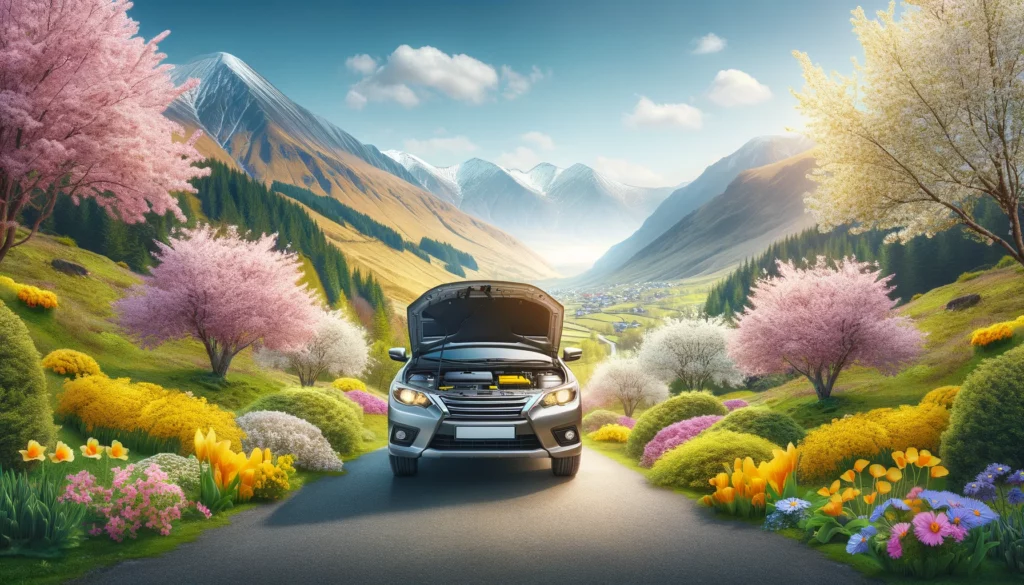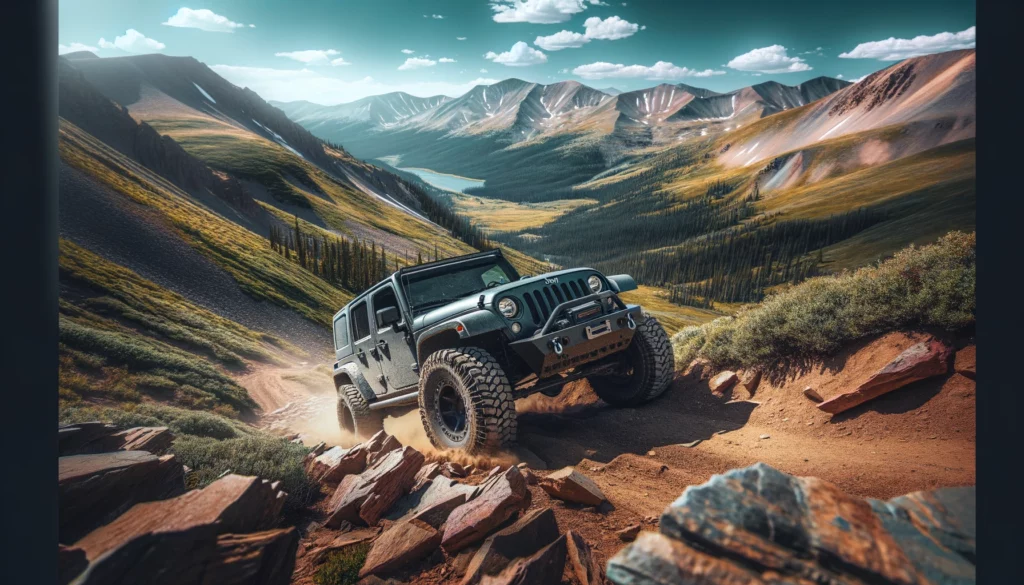Winter in Colorado can be beautiful, but it also challenges drivers. With snowfall, icy roads, and colder temperatures, preparing for roadside emergencies is more crucial than ever. This article will share essential winter roadside safety tips to help you navigate Colorado’s winter safely.
Stay prepared this winter. For reliable winter roadside assistance in Colorado, M&H Towing and Recovery.
Table of Contents
1. Prepare Your Vehicle for Montrose Winters
As the winter season approaches in Colorado, ensuring your vehicle is equipped to handle harsh weather conditions is crucial. Preparing your car for winter not only enhances your safety but also helps in avoiding potential roadside emergencies. Here’s how to get your vehicle winter-ready:
- Winterize Your Car:
- Battery Check: Cold weather can reduce battery power. Have your battery tested to ensure it’s in good condition, and replace it if necessary.
- Antifreeze Levels: Ensure the coolant is appropriate for winter temperatures to prevent freezing.
- Heater and Defroster Check: Properly functioning heaters and defrosters are essential for comfort and visibility.
- Brake Inspection: Have your brakes checked and serviced. Icy and snowy roads require optimal braking performance.
- Exhaust System: Ensure the exhaust system is free from leaks to prevent carbon monoxide poisoning, especially when idling in snow.
- Tire Check:
- Winter Tires: In snowy and icy conditions, winter tires provide better traction than all-season tires.
- Tire Pressure: Regularly monitor tire pressure; cold weather can cause it to drop, affecting traction and fuel efficiency.
- Tire Tread Depth: Ensure your tires have sufficient tread depth to grip snowy roads effectively.
- Visibility is Key:
- Windshield Wipers: Replace worn wipers with winter or all-weather wipers for better performance against ice and snow.
- Windshield Washer Fluid: Use a winter formula that won’t freeze and keep the reservoir full.
- Clear Snow and Ice: Always remove snow and ice from your windshield, windows, lights, and mirrors before driving.
- Lights Check:
- Headlights and Taillights: Ensure all lights are working correctly and are clear of snow and ice for maximum visibility and to signal your presence to other drivers.
- Oil and Filters:
- Engine Oil: Consider switching to a winter-grade oil that flows more easily at lower temperatures.
- Filters: Check and replace air and fuel filters if necessary, as clogged filters can reduce engine performance and efficiency.
These steps will help ensure your vehicle is ready for Colorado’s winter roads. Regular maintenance and checks are key to preventing breakdowns and staying safe during the cold months. Remember, a well-prepared vehicle is your first defense against winter driving challenges.
2. Pack a Winter Emergency Kit
Having a well-equipped winter emergency kit in your vehicle is essential for staying safe and prepared in case of a roadside emergency during Colorado’s harsh winter months. Your kit should include items that will help you stay warm, visible, and able to handle common winter car issues. Here’s what to pack:
- Snow Removal Tools:
- Snow Shovel: A compact, collapsible shovel for clearing snow around your tires or digging out your vehicle.
- Windshield Scraper: Essential for removing ice and snow from your windows and mirrors for clear visibility.
- Traction Aids:
- Sand, Kitty Litter, or Road Salt: These can be spread under tires to provide traction on icy surfaces.
- Tire Chains: If you frequently drive in heavy snow, consider keeping tire chains for added traction.
- Warmth and Comfort:
- Blankets or Sleeping Bags: Pack heavy blankets or sleeping bags to stay warm if you’re stranded in cold conditions.
- Extra Clothing: Include warm hats, gloves, scarves, and even a change of clothes if you get wet.
- Hand and Foot Warmers: Disposable or reusable hand and foot warmers can provide quick warmth.
- Safety and Visibility:
- Flashlights and Extra Batteries: LED flashlights or headlamps are essential for visibility during night-time emergencies.
- Reflective Triangles and Road Flares: These help other drivers see your vehicle, especially during low visibility conditions.
- Basic Tools and Supplies:
- Multi-Tool or Basic Tool Kit: Useful for simple car repairs or adjustments.
- Duct Tape and Tow Rope: Duct tape is for temporary fixes, and a tow rope is for pulling your vehicle out of the snow.
- Food and Water:
- Non-Perishable Snacks: Energy bars, dried fruits, nuts, or jerky can provide essential energy during a wait.
- Water: Store water bottles and consider insulated containers to prevent freezing.
- Communication and Navigation:
- Portable Phone Charger: Keep a fully charged power bank to ensure your phone stays on for communication.
- Physical Maps: In case of GPS failure or poor signal, having a physical map of the area can be invaluable.
- First Aid Kit:
- Comprehensive First Aid Kit: Include bandages, antiseptic wipes, pain relievers, and any personal medications.
- Miscellaneous Items:
- Whistle: Can be used for signaling help.
- Paper and Pen: Useful for leaving notes or writing down information.
Remember, the key to winter roadside emergencies is to stay warm, visible, and hydrated until help arrives. This emergency kit can be a lifesaver, especially in areas with severe winter conditions like Montrose, Colorado.
3. Driving in Snow and Ice in Montrose, Colorado
Navigating Colorado roads in winter demands special attention and techniques due to snow and ice. Here are some crucial tips to help you drive safely during these challenging conditions:
- Adjust Your Driving Habits:
- Reduce Speed: Speed is a major factor in winter driving accidents. Drive slowly to account for decreased traction on snow or ice.
- Increase Following Distance: Extend the space between you and the vehicle ahead. A normal three-second gap should be increased to at least six seconds on snowy or icy roads.
- Smooth Operations: Avoid sudden maneuvers. Accelerate, decelerate, and turn gently to reduce the risk of skidding.
- Handling Skids:
- Stay Calm: If your vehicle starts to skid, remain calm. Panicking can make the situation worse.
- Steer Into the Skid: Gently steer in the direction you want to go. If your rear wheels are sliding left, steer left.
- Avoid Overcorrecting: Rapid steering adjustments can lead to a spin. Make smooth, gradual movements.
- Braking Techniques:
- Antilock Brakes (ABS): If your vehicle has ABS, press the brake pedal firmly and hold it. The ABS will pump the brakes for you.
- Non-ABS Brakes: Use threshold braking by keeping the heel of your foot on the floor and using the ball of your foot to apply firm, steady pressure on the brake pedal.
- Use Technology Wisely:
- Traction Control Systems: These systems help prevent wheelspin during acceleration by automatically adjusting the throttle or applying brakes.
- Electronic Stability Control: This can help control skidding by automatically applying brakes to individual wheels.
- Visibility and Awareness:
- Clear Your Car: Ensure your car is free of snow, including the roof, lights, and windows, to improve visibility and prevent snow from falling onto other drivers.
- Headlights On: Keep your headlights on for better visibility, even during the day.
- Stay Alert: Watch for ice patches, especially on bridges, overpasses, and shaded areas where ice forms quickly.
- Know Your Route:
- Plan Ahead: Check the weather and road conditions before you leave. If conditions are bad, consider postponing your trip.
- Familiar Roads: Stick to well-known routes and avoid back roads or shortcuts through less-traveled areas.
- Emergency Situations:
- Avoid Stopping on the Ice: It’s harder to start moving and gain traction on icy surfaces. If you can, stop until you reach a less icy spot.
- Hill Climbing: Don’t power up hills. Applying extra gas on snow-covered roads can make your wheels spin. Try to get a little inertia going before you reach the hill, and let that inertia carry you to the top.
Following these tips can increase your safety and confidence when driving on snowy and icy roads in Colorado. Always prioritize safety over speed, and remember that the best way to avoid winter driving issues is to stay off the roads during severe weather conditions.
4. What to Do if You Get Stranded
Getting stranded in your vehicle during a Colorado winter can be a serious situation. Knowing what to do can help keep you safe and increase your chances of getting help quickly. Here are steps to follow if you find yourself stranded in the snow:
- Stay With Your Vehicle:
- Your vehicle offers shelter and makes it easier for rescuers to find you. Only leave your vehicle to search for help if you can see a building nearby where you know you can take shelter.
- Conserve Fuel:
- Run your engine sparingly. Turn it on just long enough to remove the chill, then shut it off to conserve fuel. This is especially important if you’re unsure how long you’ll need to wait for help.
- Stay Visible:
- Tie a brightly colored cloth (preferably red or orange) to your car’s antenna or place it at the top of a rolled-up window to signal distress. At night, keep your dome light on if possible. It only uses a small amount of electricity and will make your car visible to rescuers.
- Clear the Exhaust Pipe:
- Ensure your exhaust pipe is clear of snow. A blocked exhaust could cause deadly carbon monoxide gas to leak into the passenger compartment while the engine is running.
- Keep Warm:
- Use whatever you have to insulate your body from the cold. Huddle with passengers for warmth and use your emergency supplies like blankets and extra clothing.
- Do exercises to keep blood circulating, but avoid overexertion and sweating, as wet clothing will make you colder.
- Stay Hydrated:
- Drink water regularly to avoid dehydration, but don’t eat snow directly, as it will lower your body temperature. Melt it first if you’re out of water.
- Conserve Battery Power:
- Use your car’s electrical power sparingly. Ration your usage of things like lights and radio to avoid draining the battery.
- Signal for Help:
- If you have a whistle, use it to attract attention. If you have flares or reflective triangles, place them around your vehicle to increase visibility to rescuers.
- Stay Calm and Assess the Situation:
- Assess your supplies, your location, and the weather conditions. If you have a cell phone and reception, call for help and provide detailed information about your location and situation.
Remember, staying put, warm, and visible in a winter emergency are your top priorities. Your vehicle is your shelter, and staying with it increases your chances of being found. Keep your emergency kit stocked and easily accessible, and always let someone know your route and expected arrival time before you travel.
5. Navigating Winter Roadside Assistance
Winter conditions in Colorado can be challenging, and knowing how to use roadside assistance effectively can make a significant difference in an emergency. Here are some tips on navigating roadside assistance during the winter months:
- Choose the Right Service:
- Ensure you have a reliable roadside assistance service that operates in winter conditions. Services specializing in or familiar with Colorado’s winter terrain and weather can be more effective in reaching you quickly and safely.
- Keep Contact Information Handy:
- Have the contact information for your chosen roadside assistance service easily accessible. Store it in your phone and keep a written copy in your glove compartment.
- Communicate Clearly:
- When calling for assistance, provide clear and precise information about your location. Use mile markers, landmarks, or GPS coordinates if possible.
- Describe your situation in detail, including the condition of your vehicle, the number of passengers, and any specific challenges you’re facing, like being stuck in snow or having a flat tire.
- Wait Safely:
- Once you’ve called for assistance, stay with your vehicle unless you’re in immediate danger. Your vehicle offers shelter and makes it easier for the service to find you.
- Keep your hazard lights on and set up flares or reflective triangles if you have them.
- Prepare for Wait Times:
- Understand that response times may be longer in severe weather conditions. Have supplies in your winter emergency kit to keep you warm and comfortable while you wait.
- Know Your Service Coverage:
- Be aware of what your roadside assistance plan covers. Some services may not cover certain situations, like vehicles stuck in deep snow off the main road.
- Battery Jump-Starts:
- Battery issues are common in cold weather. If you need a jump-start, make sure you know how to do it safely or wait for professional help to prevent accidents.
- Tow Services:
- If your vehicle needs to be towed, know where you want it to be taken (e.g., nearest service station, home). Remove any valuable items from your vehicle before it’s towed.
- Stay Informed:
- Check weather reports and road conditions if you’re expecting roadside assistance. This can give you an idea of when to expect help and if there are any additional precautions you should take.
- After-Service Check:
- Once assistance arrives and your situation is resolved, ensure your vehicle is safe to drive. Ask the service provider for any necessary advice or follow-up actions.
Navigating roadside assistance during Colorado’s winter requires some preparation and knowledge. By following these tips, you can ensure a smoother and safer experience in case of a roadside emergency during the colder months.
6. Avoiding Hypothermia and Frostbite
In the cold winter months of Colorado, being stranded on the roadside can put you at risk of hypothermia and frostbite. Understanding how to prevent and recognize the signs of these conditions is crucial for your safety. Here’s what you need to know:
- Understanding Hypothermia:
- Hypothermia occurs when your body loses heat faster than it can produce it, causing a dangerously low body temperature.
- Signs of Hypothermia: Uncontrollable shivering, memory loss, confusion, slurred speech, drowsiness, and exhaustion.
- Preventing Hypothermia:
- Stay Dry: Wet clothing greatly increases the risk of hypothermia. Remove any wet clothing and replace it with dry garments.
- Insulation: Use blankets, sleeping bags, and extra clothing in your emergency kit to keep warm.
- Physical Activity: Perform mild exercises to maintain body heat, but avoid overexertion which can cause sweating and damp clothing.
- Understanding Frostbite:
- Frostbite is the freezing of skin and underlying tissues, often affecting the nose, ears, cheeks, chin, fingers, or toes.
- Signs of Frostbite: Numbness, tingling, stinging, aching, pale or grayish-yellow skin, hard or waxy-looking skin.
- Preventing Frostbite:
- Cover Exposed Skin: Wear hats, gloves, face masks, and other clothing to protect against exposure.
- Avoid Tight Clothing: Tight clothing can reduce blood circulation to extremities. Ensure clothing and boots are snug but not too tight.
- Warm Up Gradually: If you suspect frostbite, warm the area gradually. Avoid direct heat, which can damage the skin. Use warm, not hot, water.
- Emergency Measures:
- If you suspect you or someone else has hypothermia or frostbite, seek medical attention immediately. If you’re waiting for help, enter a warm vehicle or building if possible.
- Do not Rub or Massage Frostbitten Areas: This can cause more damage to the tissue.
- Warm Drinks: If conscious and able, consume warm, sweet beverages (non-alcoholic) to increase body heat.
- Stay Informed and Prepared:
- Keep updated on the weather forecast, especially when planning to travel. Avoid unnecessary travel during severe weather warnings.
Remember, the key is prevention. By staying warm, dry, and informed, you can significantly reduce the risk of hypothermia and frostbite during the cold Colorado winter. In any emergency, prioritize calling for professional help.
7. Conclusion
Winter driving in Colorado presents unique challenges, but with the right preparation and knowledge, you can navigate these conditions safely. The key is to be proactive about vehicle maintenance, pack a comprehensive emergency kit, adjust your driving habits for winter road conditions, and know what to do if you get stranded. Understanding how to use roadside assistance effectively, recognizing the signs of hypothermia and frostbite, and preventing hypothermia and frostbite are also crucial for your safety.
- Stay Informed: Always check the weather forecast before heading out and be aware of any winter storm warnings or advisories.
- Plan Your Route: Choose the safest route and let someone know your travel plans, including your expected arrival time.
- Regular Vehicle Checks: Keep your vehicle well-maintained and serviced, especially during the winter months.
- Emergency Kit: Regularly update your winter emergency kit and keep it easily accessible in your vehicle.
- Safe Driving Practices: Slow down, increase following distance, and be vigilant about the road conditions and your surroundings.
- Stay Calm in Emergencies: If stranded, stay with your vehicle, conserve resources, and signal for help.
Winter driving can be intimidating, but being well-prepared can make all the difference. Remember, your safety and the safety of others on the road should always be your top priority. If conditions are too severe, consider postponing your trip. Safe and responsible driving ensures that everyone can enjoy the beauty and fun Colorado winters offer.
For any roadside assistance needs this winter, M&H Towing and Recovery is here to help. Keep our number handy, and don’t hesitate to call us in an emergency. Drive safe and stay warm!



